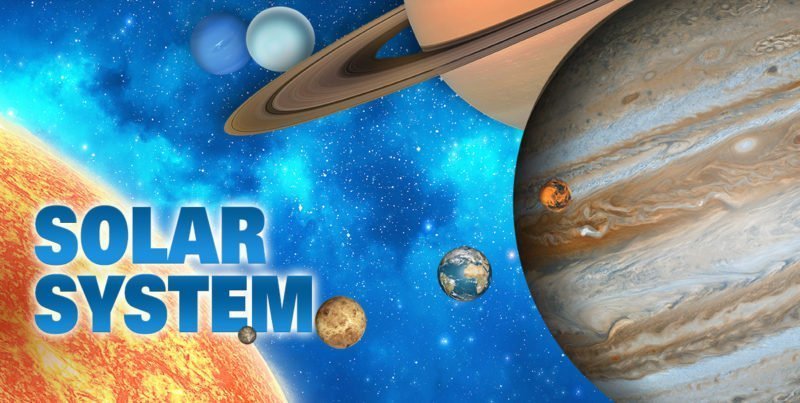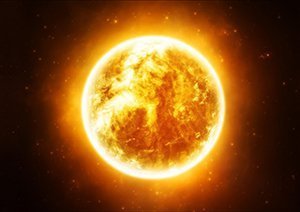 Sun
Sun
Size: Diameter of around 1.4 million km (This is nearly 110 times the diameter of Earth, meaning one million Earths could fit in the Sun!)
Temperature: The centER of the sun can reach 15 million degrees Celsius.
Type: Yellow Dwarf Star (the sun combines hydrogen and helium to make energy)
Made of: Hydrogen, Helium
Fun Fact: The sun is halfway through its life. At 4.5 billion years old, the Sun has burned off almost half of its hydrogen and only has enough to burn it for another 5 billion years.
 Mercury
Mercury
Size: Smallest of the 8 planets in our solar system – Diameter is 4,879 km
Temperature: Ranges from -170 degrees Celsius at night and 430 degrees Celsius during the day
Type: Terrestrial Planet
Made of: Mainly iron, and a thin crust of silicate
Fun Fact: The orbit of Mercury is a not circular; it is an ellipse.
 Venus
Venus
Size: 3rd Smallest of the 8 planets in our solar system – Diameter is 12,104 km
Temperature: Average Surface Temperature 462 degrees Celsius (Hottest Planet in the Solar System)
Type: Terrestrial Planet
Made of: Iron core, rocky mantle, and atmosphere is mainly carbon dioxide
Fun Fact: Venus Rotates in the opposite direction to other planets. It rotates clockwise, when most other planets rotate counter-clockwise.
 Earth
Earth
Size: 4th smallest of the 8 planets in our solar system – Diameter is 12,742 km
Temperature: Average temperature is around 16 degrees Celsius
Type: Terrestrial Planet
Made of: Mainly Oxygen on the crust, and also many other rocks and minerals like silicon, aluminum, etc.
Fun Fact: Earth is the most dense planet in the solar system. Even though the density differs in each part of the planet, the average density is around 5.52 grams per cubic centimeter.
 Mars
Mars
Size: 2nd smallest of the 8 planets in our solar system – Diameter is 6,779 km
Temperature: On a summer day, the temperature can get up to 20 degrees Celsius near the equator, but at night it can go to minus 73 degrees Celsius.
Type: Terrestrial Planet
Made of: A layer of dust on the surface and the crust consists of volcanic basalt rock
Fun Fact: With the exception of Earth, Mars is the most hospitable for life.
 Jupiter
Jupiter
Size: Biggest out of the 8 planets in our solar system – Diameter is 139,882 km
Temperature: The temperature in the clouds of Jupiter is about minus 145 degrees Celsius, but near the core, it can be about 24,000 degrees Celsius.
Type: Gas Giant Planet
Made of: Atmosphere mostly hydrogen and helium gas and the planet is covered in clouds.
Fun Fact: Jupiter has 67 confirmed moons orbiting the planet.
 Saturn
Saturn
Size: 2nd biggest out of the 8 planets in our solar system – Diameter is 116,464 km
Temperature: Average temperature is minus 178 degrees Celsius
Type: Gas Giant Planet
Made of: 94% Hydrogen
Fun Fact: Saturn is the least dense planet in the solar system, since it is made out of hydrogen. Hydrogen has a density less than water, meaning Saturn could technically float!
 Uranus
Uranus
Size: 3rd biggest out of the 8 planets in our solar system – Diameter is 50,724 km
Temperature: Near the cloud tops, the temperature of Uranus is around -357 degrees Celsius
Type: Gas Giant Planet
Made of: mostly composed of ices, like water, ammonia, and methane
Fun Fact: A collision may have caused the unusual tilt of Uranus. The theory is that a planet the size of earth may have collided with uranus, forcing the axis to shift drastically.
 Neptune
Neptune
Size: 4th Biggest out of the 8 planets in our solar system – Diameter is 49,244 km
Temperature: Average temperature is -214 degrees Celsius
Type: Gas Giant Planet
Made of: Many different elements, including hydrogen, helium, and other ices
Fun Fact: Neptune has the second largest gravity of any planet.














